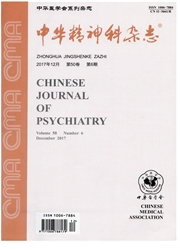

 中文摘要:
中文摘要:
目的 探讨海洛因成瘾者默认网络的功能影像学改变。方法 14例海洛因成瘾者(海洛因成瘾组)和14名对照者(对照组)进行静息态fMRI扫描,采用独立成分分析方法分别提取海洛因成瘾组和对照组的默认网络进行组内及组间分析,以了解成瘾者默认网络功能连接改变的脑区。结果 与对照组比较,海洛因成瘾组默认网络的额上回内侧(t=-2.61)、前扣带回(t=-3.32)及楔叶(t左=-3.49,t右=-3.40)的功能连接减弱,后扣带回(t=4.55)、楔前叶(t左=4.31,t右=3.54)以及角回(t左=2.57,t右=6.39)的功能连接增强,均P〈0.05。结论 静息态下海洛因成瘾者的默认网络存在功能连接异常。
 英文摘要:
英文摘要:
Objective To investigate the functional imaging alteration of default mode network (DMN) and its significance in heroin addicts by using the functional magnetic resonance imaging (fMRI) technology and independent component analysis ( ICA). Methods Resting state fMRI data of 14 heroin addicts and 14 normal controls were analyzed by using ICA, and then the difference of functional connectivity in the DMN was acquired by analyzing the data of intra-group and inter-group respectively. Results Compared with the normal controls, heroin addicts showed decreased functional connectivity in the medial superior frontal gyms (t = - 2. 61 ), anterior cingutate cortex ( t = - 3.32) and cuneus ( tleft = - 3.49, tright=-3.40); and increased functional connectivity in the posterior cingulate cortex (t = 4.55), precuneus (tleft, = 4. 31, tright = 3. 54 ) and angular gyrus ( tleft = 2. 57, tright=6. 39 ) in the DMN ( all P 〈 0. 05 ). Conclusion The DMN of heroin addicts may have abnoimal functional connectivity at resting state.
 同期刊论文项目
同期刊论文项目
 同项目期刊论文
同项目期刊论文
 期刊信息
期刊信息
